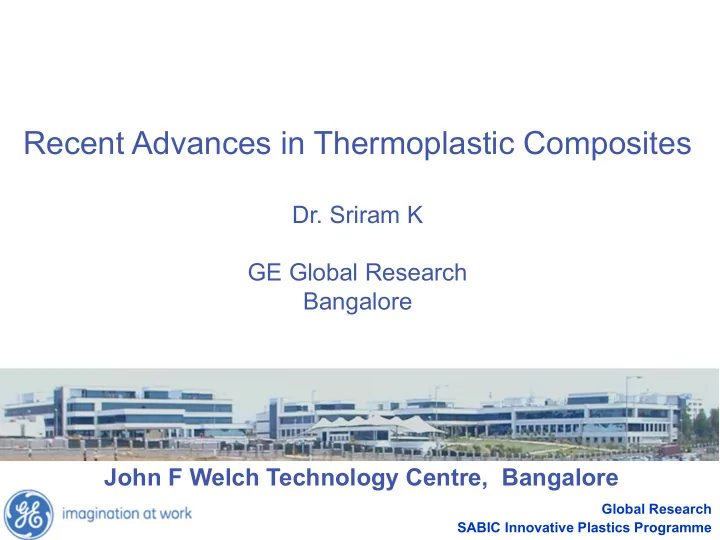

Recent Advances in Thermoplastic Composites Dr. Sriram K GE Global Research Bangalore John F Welch Technology Centre, Bangalore Global Research SABIC Innovative Plastics Programme
Thermoplastics Market HIGH PERFORMANCE PLASTICS LCP PEI GE Polymers PPS PSU PEEK PA PA T g , Heat Stability, ENGINEERING PLASTICS blends Processing PC PBT PPE / PS temperature and Cost blends blends PBT blends POM PMMA PET PC ABS Polypropylene COMMODITIES PS HIPS PVC Polyethylene AMORPHOUS SEMICRYSTALLINE Global Research SABIC Innovative Plastics Programme
Thermoplastic Composites Specialty polymers reinforced with Fibre Carbon, Aramid fibres and/or Process Modulus Sandwiched with cores Length V f (%) (GPa) Compression, 200 70 % Continuous Pultrusion, Autoclave ATC’s 50 % GMT 25 10 mm Glass mat Thermoplastics LFT Long Fibre Thermoplastics 30 % Injection 15 Moulding 5 mm Chopped Fibres 15 % 5 ATC’s - Advanced Thermoplastic Composites Global Research SABIC Innovative Plastics Programme
Thermoplastics Composites � Advanced Thermoplastic Composites � Nanocomposites Global Research SABIC Innovative Plastics Programme
Advanced Thermoplastic Composites Advantages of Thermoplastics over Thermosets Recycleability High Toughness Drapability Low cycle time Online repair / re-shaping and Weldability No toxic gas emission during processing No shelf life for resin Challenges Fibre-matrix Adhesion/Impregnation High temperature processing High viscosity High Residual Stresses Why is this so challenging? • Many thousands of small diameter fibres, • packed very closely together , • to be impregnated with very viscous , complex liquids. impregnating resin Global Research SABIC Innovative Plastics Programme
Pultrusion Process Glass Strand Force Rungs Thermoplastic Pultrusion Polymer Mix Pultrusion Finishing/ Glass Creels Wet Bath Puller Pelletizer Block Packaging LGF Vf = 30 – 70 % Global Research SABIC Innovative Plastics Programme
Long Fibres vs. Short Fibres • Fiber length retention provides skeletal matrix • Critical to high impact/modulus relationship • Standard pellet length = 11mm • Typical fiber lengths in molded parts = 6mm+ Global Research SABIC Innovative Plastics Programme
Continuous fibre Composites Monomers Melt Reactive Polymers Processin Processin g g Polymerisatio Powder Yarn Powder coated n Commingled Prepreg Stacked Laminate fabric Fabric Composite Structural Part Time Global Research SABIC Innovative Plastics Programme
In-mold Polymerized Thermoplastic Composites Source: K.van Rijswijk et. al. Composites Part A, V38, 2007. PBT PC PPS PEEK Global Research SABIC Innovative Plastics Programme
In-mold Polymerized Thermoplastic Composites • Processing advantages over thermosets materials No toxic generation, High productivity, Mechanicals, durability and environmental advantages of thermoplastics • Solid low viscosity oligomers – 75 % Carbon fiber fiber loading • Masterbatches for thermoplastics • Continuous fiber prepregs • Nanocomposites-dispersion exfoliation • Smart fillers – conducting, self-healing. Carbon-fiber prepreg Wind-turbine blades tapes impregnated and automotive with CBT resin could composites are some be used as a of the applications reinforcing wrap for being actively older concrete investigated for new structures such as in-mold polymerized bridges. The PBT resins. These thermoplastic tape thermoplastic can be heated and composites would be bent around corners. recyclable. Global Research SABIC Innovative Plastics Programme
Source: Sriram K et. al. SAMPE, 2005. Residual Stresses • Fibre movement during low Process Related Issues viscosity stage of the resin. • Reduces compressive and hot/wet properties of composites Residual Stress Fibre misalignment Fibre Prestressing Methodology • Develops due to the anisotropic Uncured matrix Uncured matrix Prestressed fibres Prestressed fibres properties of the constituents. 1 1 Thermal Expansion Matrix tensile residual stress Matrix tensile residual stress E-glass a f = +4.9 × 10 -6 K -1 2 2 Polycarbonate a m = +60 to 70 × 10 -6 K -1 Fibre/matrix adhesion Fibre/matrix adhesion 3 3 Compressive stress Compressive stress Fibre 600 EFPI Middle EFPI 40 mm from edge 400 Matrix ERSG Middle ERSG 40 mm from edge 200 Residual strain ( µε ) FBG Middle 0 Unidirectional Composite -200 -400 -600 -800 Global Research -20 0 20 40 60 80 100 120 140 160 Prestress (MPa) SABIC Innovative Plastics Programme
Sandwich Structures Manufacturing Fibre/Polymer Tape Shaping to Laminates Design and Mechanical Testing Producing exterior and interior face sheets Honeycomb Core Foam Core Structural Panel Thermoplastic Honeycomb cores ABS - for rigidity, impact strength, toughness, surface hardness and dimensional stability Polycarbonate - for UV-stability, excellent light transmission, good heat resistance properties Polypropylene - for good chemical resistance Polyethylene - a general-purpose low-cost core material Global Research SABIC Innovative Plastics Programme
Nanocomposites 100 Plastics Compounds (B lbs.) Plastics Nano 9.8 % % Nano 75 composites 2.2 % 0.6 % 0.3 % 50 25 0 2005 2010 2015 2020 Source: Freedonia Nano Composites Source: Bodo Fiedler et. al. CST, V66, 2006 Macro vs Nano: Interface Richard A Vaia and Daniel Wagner; Materials Today Nov. 2004 Global Research SABIC Innovative Plastics Programme
Value Proposition for Nanocomposites Barrier Mechanical Source: Polymer, V47, Iss.8, 2006 Heat Release Rate FR Nexans’ plenum cable jacketing, the first such product in the U.S. Sud- Chemie’s nanoclay in polyolefin cable Global Research jacket SABIC Innovative Plastics Programme Materials Science and Engineering 28 (2000) 1.
The Processing Challenge Key Challenge in Key Challenge in 8 µ m particle 8 µ m particle Nanocomposites is Nanocomposites is Dispersion Dispersion > 3000 platelets > 3000 platelets Chemistry Chemistry Chemistry/Processing Chemistry/Processing Processing Processing Tactoids/ Tactoids/ Intercalants Intercalants Partial Partial Tactoids/ Tactoids/ Intercalants Intercalants Dispersion Dispersion Dispersed Dispersed Dispersed Dispersed Surface treatment of Nanoclay Major Challenges Ahead…. • Compatibility of surface chemistry to matrix Exfoliation • High Temperature stability of surface modifier • Repeatability in the plant scale 5% Nanoclay / Treated with Methacryloethoxyhexadecyl dimethyl Polystyrene ammonium bromide (MHAB) Global Research Source: http://www.chbmeng.ohio- SABIC Innovative Plastics Programme state.edu
Environmental Friendly Bio-Polymers Thermoplastics Thermosets Millimetre Micro Nano Time Global Research SABIC Innovative Plastics Programme
Acknowledgements Dr. Sanjay Charati Dr. Gautam Chatterjee Dr. Soumyadeb Ghosh Global Research SABIC Innovative Plastics Programme
Recommend
More recommend